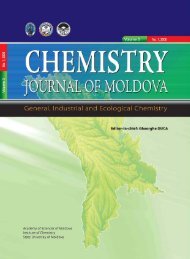2011, nr. 3 - Academia de ÅtiinÅ£e a Moldovei
2011, nr. 3 - Academia de ÅtiinÅ£e a Moldovei
2011, nr. 3 - Academia de ÅtiinÅ£e a Moldovei
You also want an ePaper? Increase the reach of your titles
YUMPU automatically turns print PDFs into web optimized ePapers that Google loves.
Ştiinţe Medicalene receptors, and interleukin-1 receptor antagonist afterintravenous immunoglobulin administration in vivo. In:Blood, 1994, 84, p. 2136-2143.3. Bieben R. Comparison of IgG, IgA and IgM preparationsfor their capacity to scavenge the activatedcomplement components C4b and C3b. 4th GermanInterdisciplinary Congress for Intensive Care andEmergency Medicine, Hamburg, 1997.4. Borsos T., Rapp H. Complement fi xation on cell surfacesby 19S and 7S antibodies. In: Sciense, 1965, 150, p.505-506.5. Bjornson A., Detmers P. The pentameric structureof IgM is necessary to enhance opsonization of bacteroi<strong>de</strong>sthetaiotaomicron and bacteroi<strong>de</strong>s fragilis via the alternativecomplement pathway. In: Mictob. Pathog., 1995, 19,p. 117-128.6. Hurez Vetal. Pooled normal human polyspecifi c IgMcontains neutralizing anti-idiotypes to IgG autoanti-bodiesof autoimmune patients and protects from experimental autoimmunedisease. In: Blood, 1997, 90, p. 4004-4013.7. Klingernann H. G. et al. Use of an immunoglobulinpreparation e<strong>nr</strong>iched for IgM (Pentaglobin®) for the treatmentof acute graft-versus-host disease. In: Bone MarrowTransplant, 1990, 6, p. 199-202.8. Mouthon Letal. Mechanism of action of intravenousimmune globulin in immunemediated diseases. In: Clin.Exp. Immunol, 1996, 104 (suppl. 1), p. 3-9.9. Ny<strong>de</strong>gger U. et al. The concept of antiidiotypic regulationof selected diseases by intravenous immunoglobin.1989, p. 72-83.10. Rinaldi M. et al. Effectiveness of Immunoglobulinsfor the prevention of systemic infections. In: Clin. Drug Invest.,1995, 10, p. 328-336.SummaryImmunomodulatory therapy in sepsis presents a newarea, one that requires measures to improve the severedisturbances, seen and <strong>de</strong>monstrated in severe inflammatorpathology. The attempts of tampering with drugs theprocesses of septic syndromes gave positive results only inlaboratory conditions, the trials have failed.PезюмеИмунномодуляторная терапия при сепсисе представляетновое перспективное направление в интенсивномлечении критического сепсиса. Однако, положительныерезультаты полученные лабораторнымиметодами оказались несостоятельными в клинике.161FORME CLINICE DE TROMBEMBOLIEA ARTEREI PULMONARE/TROMBOZĂPULMONARĂ LA BOLNAVIICHIRURGICALI_______________________________________Olga Cuşnir, doctorandUSMF „Nicolae Testemiţanu”Introducere. În literatura <strong>de</strong> specialitate suntfoarte bine <strong>de</strong>scrise formele clinice ale trombembolieiarterei pulmonare (TEAP). Noi nu am întâlnitînsă în literatura accesibilă repartizarea bolnavilor cutromboză pulmonară (TP) după forme clinice. Similitudineasemnelor şi simptomelor clinice caracteristicepentru TEAP/TP în acest context ne-a permis săstabilim variantele clinice ale acestei patologii, caresunt extrem <strong>de</strong> valoroase în <strong>de</strong>terminarea sindromuluişi diagnosticarea diferenţială. Este cunoscut faptul cătromboza pulmonară are geneză locală (pulmonară),iar TEAP este un sindrom pulmonar <strong>de</strong>clanşat <strong>de</strong> cauzeextrapulmonare.Material şi meto<strong>de</strong>. În studiu au fost incluşi 112cu TEAP şi 27 pacienţi cu tromboză pulmonară (TP),internaţi în clinica <strong>de</strong> anesteziologie şi reanimatologiea Catedrei <strong>nr</strong>. 2 <strong>de</strong> Anesteziologie şi Reanimatologie.Vârsta pacienţilor varia între 28 şi 73 <strong>de</strong> ani.Diagnosticul a fost stabilit pe baza datelor clinice, <strong>de</strong>laborator şi ale explorărilor paraclinice. Pacienţii aufost divizaţi în conformitate cu prepon<strong>de</strong>renţa sindroamelorclinice prezente în momentul internării însecţia <strong>de</strong> terapie intensivă.Rezultate şi discuţii. Studiind şi analizând multitudinea<strong>de</strong> semne clinice prezente la această categorie<strong>de</strong> pacienţi, am putut repartiza bolnavii care au <strong>de</strong>zvoltatTEAP forma pleuropulmonară – 27 (24,10%),forma cardiovasculară – 41 (36,60%), forma abdominală– 2 (1,78%), forma renală – 6 (5,35%) forme,mixte – 32 (28,57%). Pacienţii cu TP am reuşit să-irepartizăm în bolnavi cu predominarea sindroamelorpleuropulmonare – 10 (37,03%), sindromuluicardiovascular – 7 (25,92%) şi forme mixte cu – 10(37,03%) pacienţi.Tabelul 1Sindroamele clinice caracteristice pacienţilor cuTEAP/TPSindroame clinice TEAP TPNr. % Nr. %Pleuropulmonare 27 24,10% 10 37,03%Cardiovasculare 41 36,60% 7 25,92%Abdominale 2 1,78% - -Cerebrale 4 3,57% - -Renale 6 5,35% - -Mixte 32 28,57% 10 37,03%Total 112 100% 27 100%
















